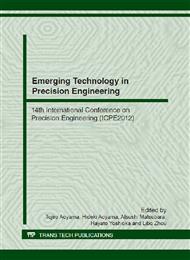[1]
Dambon, O. et al., Efficient mold manufacturing for precision glass molding, Journal of Vacuum Science Technology B 27, 1445, (2009)
Google Scholar
[2]
Su, L.; Yi, A., Investigation of the effect of coefficient of thermal expansion on prediction of refractive index of thermally formed glass lenses using FEM simulation, Journal of Non-Crystalline Solids, Volume 357, pp.3006-3012, (2011)
DOI: 10.1016/j.jnoncrysol.2011.04.005
Google Scholar
[3]
Bifano, T.G., Ductile regime grinding of brittle materials, PhD Thesis, North Carolina State University, (1988)
Google Scholar
[4]
Brinksmeier et al., Dressing of Coarse-Grained Diamond Wheels for Ductile Machining of Brittle Materials, Towards Synthesis of Micro-/Nanosystems, pp.305-307, (2007)
DOI: 10.1007/1-84628-559-3_53
Google Scholar
[5]
Liu, K.; Li, X. P., Ductile cutting of tungsten carbide. Journal of Materials Processing Technology, 113, pp.348-354, (2001)
DOI: 10.1016/s0924-0136(01)00582-9
Google Scholar
[6]
Liu, K., Li, X. P., Rahman, M.; Liu, X. D., CBN tool wear in ductile cutting of tungsten carbide. Wear, 255, pp.1344-1351, (2003)
DOI: 10.1016/s0043-1648(03)00061-9
Google Scholar
[7]
Suzuki, H. et al., Study on precision grinding of micro aspherical surface: effects of tool errors on workpiece form accuracies and its compensation methods, Journal of the Japan Society for Precision Engineering, 65, pp. l401-405, (1999)
DOI: 10.2493/jjspe.65.401
Google Scholar
[8]
Huang, H., Chen, W.K. and Kuriyagawa, T., Profile error compensation techniques in parallel nanogrinding of tungsten carbide aspherical mould inserts. International Journal of Machine Tool and Manufacture, 47, pp.2237-2245, (2007)
DOI: 10.1016/j.ijmachtools.2007.06.008
Google Scholar
[9]
Yamamoto, Y et al., Precision grinding of microarray lens molding die with 4-axes controlled microwheel, Science and Technology of Advanced Materials, 8, pp.173-176, (2007)
DOI: 10.1016/j.stam.2007.02.007
Google Scholar
[10]
Suzuki, H. et al., Precision Cutting of Aspherical Ceramic Molds with Micro PCD Milling Tool, CIRP Annals - Manufacturing Technology, 56, pp.131-134, (2007)
DOI: 10.1016/j.cirp.2007.05.033
Google Scholar
[11]
Boehlke, W.: Hartmetall - ein moderner Hochleistungswerkstoff, Materialwissenschaften und Werkstofftechnik , no. 33, p.575 – 580, (2002)
DOI: 10.1002/1521-4052(200210)33:10<575::aid-mawe575>3.0.co;2-1
Google Scholar
[12]
Salmang, H.; Scholze, H.; Telle, R.: Keramik, Springer-Verlag Berlin Heidelberg, (2007)
Google Scholar


